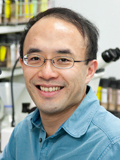RIKEN Center for Biosystems Dynamics Research Laboratory for Epithelial Morphogenesis
Team Leader: Yu-Chiun Wang (Ph.D.)
Research Summary

The central question in developmental biology is how cells, tissues and organs acquire their specific functions and shapes. A large body of work over the past several decades has yielded a broad understanding of how functional specialization is achieved through differential gene expression. In contrast, far less is known about how cell shapes and tissue structures are controlled and remodeled. Although a general theme has emerged whereby cytoskeletal elements control the cell shapes, while alteration of individual cell shapes collectively organizes the tissue architecture, the underlying molecular and mechanical mechanisms remain poorly understood. My lab aims at identifying novel mechanisms that orchestrate the formation of three-dimensional epithelial structures. Our long-term goal is to comprehensively understand the mechanistic principles of tissue morphogenesis in order to conceptualize the origin of morphological diversity both within an organism and among evolutionary lineages.
We are currently focusing on how modifications of epithelial cell polarity control cell shapes using gastrulating Drosophila embryos as the model system. Our previous work identified a novel mechanism for cell shape changes whereby cell shortening is induced upon a basal repositioning of the apical-basal polarity and cell-cell adhesive apparatus adherens junctions. The cell shortening occurs in two narrow strips of cells, producing heterogeneities in cell height within the tissue, thereby allowing it to bend. The polarity-based mechanism represents the first instance wherein the initiation of epithelial folding does not involve the canonical myosin-dependent apical constriction. Since cell-cell adhesion and apical-basal polarization are two fundamental features of epithelial tissues, our work potentially heralds a general mechanism for cell shape changes and epithelial folding. In addition, we found that after initiation, the depths of epithelial folds differ depending on the degrees of neighboring cell invagination. Genetic evidence suggests that the strength of mechanical coupling between adherens junctions and their underlying actin cytoskeleton determines the extent of cell invagination. Our ongoing work promises to identify genes and forces that sculpt distinct morphological features.
We employ an integrated approach that combines genetic manipulation, two-photon deep tissue live imaging and computational cell shape reconstruction. We are also in the process of designing novel imaging strategies that could be used to visualize mechanical forces and computational algorithms that reconstruct and quantify 4D cell shapes. Furthermore, we will launch a multidisciplinary, international collaboration that combines genetics, computational and evolutionary approaches to analyze the history and function of transiently formed epithelial structures that do not eventually contribute to a body part or organ.
Main Research Fields
- Biology
Related Research Fields
- Biological Sciences
Keywords
- Tissue morphogenesis
- Cell shape change
Selected Publications
Papers with an asterisk(*) are based on research conducted outside of RIKEN.
- 1.Wen, F. –L., Wang, Y. -C. and Shibata, T.:
"Epithelial folding driven by apical or basal-lateral modulation: geometric features, mechanical inference, and boundary effects."
Biophys J 112.2683-95 (2017) - 2.*Khan, Z., Wang, Y.-C., Wieschaus, E. F. and Kaschube, M.:
"Quantitative 4D analyses of epithelial folding during Drosophila gastrulation."
Development 141.2895-900 (2014) - 3.*Gavin-Smyth, J., Wang, Y.-C., Butler, I., and Ferguson, E. L.:
"A genetic network conferring canalization to a bistable patterning system in Drosophila."
Curr Biol 23.2296-302 (2013) - 4.*Wang, Y.-C., Khan, K., and Wieschaus, E. F.:
"Distinct Rap1 activity states control the extent of epithelial invagination via alpha-catenin."
Dev Cell 25.299-309 (2013) - 5.*Wang, Y.-C., Khan, Z., Kaschube, M., and Wieschaus, E. F.:
"Differential positioning of adherens junctions is associated with initiation of epithelial folding."
Nature 484.390-3 (2012) - 6.*Wang, Y.-C., and Ferguson, E. L.:
"Spatial bistability of Dpp-receptor interactions during Drosophila dorsal-ventral patterning."
Nature 434.229-34 (2005) - 7.*Podos, S. D., Hanson, K. K., Wang, Y.-C., and Ferguson. E. L.:
"The DSmurf ubiquitin-protein ligase restricts BMP signaling spatially and temporally during Drosophila embryogenesis."
Dev Cell 1.567-78 (2001)
Recent Research Results
Related Links
Lab Members
Principal investigator
- Yu-Chiun Wang
- Team Leader
Core members
- Chun Wai Kwan
- Research Scientist
- Sameer Thukral
- Special Postdoctoral Researcher
- Bipasha Dey
- Postdoctoral Researcher
- Anne Rosfelter
- Postdoctoral Researcher
- Michiko Takeda
- Technical Staff I
- Nishita Gattani
- Research Associate
- Nada Dougui
- Research Associate
- Yuko Fujiyama
- Assistant
Contact Information
5F, RIKEN BDR Developmental Biology Bldg.A, 2-2-3 Minatojima-minamimachi, Chuo-ku
Kobe, Hyogo
650-0047 Japan
Email: ycwang [at] cdb.riken.jp
